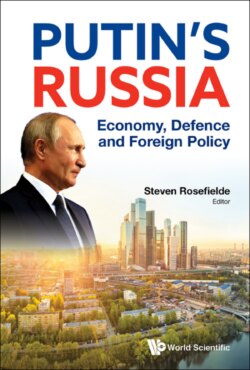Читать книгу Putin's Russia - Группа авторов - Страница 23
На сайте Литреса книга снята с продажи.
Growth Actual growth since the start of transition
ОглавлениеRussia’s growth since 1991 has gone through several phases as can be seen in Figure 2. These phases are explained by a mix of fundamental growth drivers, external shocks and domestic policies. The problem for Russian voters (and sometimes also for researchers and policymakers) is to disentangle those changes in their income that are due to a capable leader’s policies from those that are simply the result of chance or a response to external shocks. The strong positive correlation between approval ratings and growth in the right panel of Figure 1 suggests that voters in more normal times rather indiscriminately reward their leader with higher ratings when growth is higher and vice versa even if much of the variation in growth is due to external factors such as changes in international oil prices. However, the global financial crisis in 2008/2009 is an example of people clearly identifying the shock to be external and where the popularity rating of the president did not fall as would otherwise be expected. The political cost of poor economic performance can also be seen in the first decade of transition from a planned economy to a more market-oriented one. This was not a smooth process, but instead growth was negative for many years and that is still reflected in peoples’ views of former leaders such as Gorbachev and Yeltsin.
Figure 2:Real GDP growth.
Source: World Bank.
Russia was not unique among transition countries to experience negative growth in the early years of transition, and both the countries that later joined the EU (EU10 in Figure 2) and the other countries that came out of the Soviet Union (FSU11) had a similar start with declining incomes.2 However, the rebound to positive growth was significantly faster among the EU10 countries than in Russia and the FSU11 countries.
The differences in growth between Russia and the peer country groups may not look so striking, but when growth differences accumulate over several years, the differences in income levels are significant. In Figure 3, the lines are broken in the first, pre-Putin, phase of transition with income levels set at 100 in 1990. By the end of 1999, Russia had lost more than 40% of its initial income level, similar to the other FSU countries but far behind the EU10 group of countries that by then had come back to where they started the transition process in terms of income levels.
Figure 3:Russia and peers GDP index (1990 = 100 then 2000 = 100).
Source: World Bank and author’s calculations.
The second part of Figure 3 restarts the comparison at the time Putin became president for the first time. With 2000 as the starting point, the FSU11 group generated the highest average growth rate, and in 2017, income levels were 2½ times of what they were in 2000. Russia was for a long time ahead of the EU10 countries in terms of growth in this period, but after the very poor growth performance after 2013, Russia was overtaken by the EU10 group as well. Nevertheless, under Putin’s watch, income in Russia had increased by 1.7 times in 2017 compared to 2000, in stark contrast to the loss of 40% of income in the first decade of transition. It is not hard to understand that the arrival of a president that coincides with a shift in economic fortunes of this scale generates ample support in the population and that a narrative of Putin creating order from chaos can take hold.
There are many external factors that affect Russia’s macroeconomic performance and the volatile and unpredictable world market price of oil is of particular importance. Oil prices have explained around two-thirds of Russian growth and account for a similar share of 1-year ahead forecast errors in the recent decades (Becker, 2017a). Over the years, Russian policymakers have adopted policies to mitigate the volatility of oil prices by first creating different versions of oil fund(s) and then abandoning the fixed exchange rate and moving to inflation targeting. Becker (2017a) shows how these latter policies were important factors in dampening the downturn in 2014 compared with the more severe decline in output that was experienced in the 2008/2009 global financial crisis. Although these measures have been important steps to deal with the shorter run implications of Russia’s oil dependence, they cannot change the fact that policies aimed at diversifying the economy are the only solutions to generate stable and sustainable growth at a level that is sufficient to close the income gap with high-income countries and stay ahead of its middle-income emerging market peers (Becker, 2018). In its October 2018 forecast of the world economy, the IMF (2018) projected that Russia will grow by 1.8%, similar to the 2% growth in advanced economies but well behind the 4.7% growth in emerging markets.
